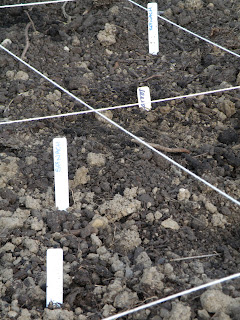What you need to make a simple, yet effective trellis:
4 - 1x2x8 pieces of lumber for the poles
4 - wood screws
2 packages of screw hooks (20 total)
String or twine (approximately 30 yards)
Level
Drill
Step 1: Arrange the screw hooks on two of the poles, spacing screw hooks 6-10 inches apart and alternating between poles.
Step 2: Use the drill to start the holes for each screw hook.
Step 3: Screw the hooks into the poles until secure.
Step 4: Drive two poles into the ground with a hammer. Poles should be approximately 8 feet apart.
Step 5. Join the two vertical poles at the top and bottom by attaching a horizontal poles with wood screws. Use the level to get the pole level.Step 6: Starting at one end, string the twine through the hooks.
Alternate the twine between the top and bottom pole.
Step 7: Tie off the twine on other end.
Step 8: (optional) Use twist ties to support the plants until they are tall enough to climb the poles.
Step 9: Watch em grow!

Since peas are more of a cold weather crop, I build a trellis on the west side of the the peas for the pole beans. This is so that beans will help to shade the peas in the afternoon.





















